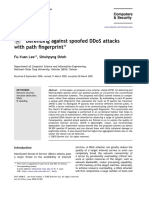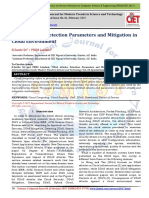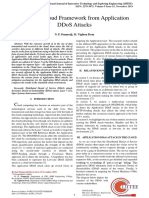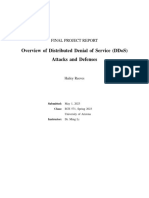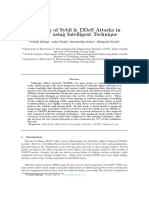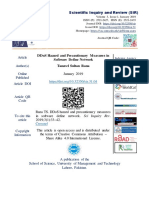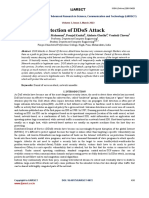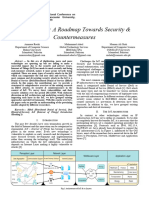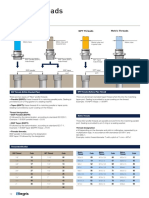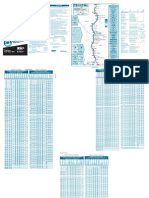Professional Documents
Culture Documents
ESOBSTEB SIP - DDoS Defense Tool An Aggressive Defense Framework For Detecting and Countering Flood Based SIP-App (D) DoS Attacks On The Internet
Original Title
Copyright
Available Formats
Share this document
Did you find this document useful?
Is this content inappropriate?
Report this DocumentCopyright:
Available Formats
ESOBSTEB SIP - DDoS Defense Tool An Aggressive Defense Framework For Detecting and Countering Flood Based SIP-App (D) DoS Attacks On The Internet
Copyright:
Available Formats
Volume 8, Issue 1, January – 2023 International Journal of Innovative Science and Research Technology
ISSN No:-2456-2165
ESOBSTEB SIP- DDoS Defense Tool: An
Aggressive Defense Framework for Detecting and
Countering Flood based SIP-App (D)DoS
Attacks on the Internet
1 2
Madaki, S. D Odachi Gabriel C
1 4
Computer Science Department, FCE(T) Asaba, Ezekwe Chinwe G
2,4
Delta State, Nigeria Department of Computing sciences, Admiralty University
of Nigeria, Ibusa, Delta State, Nigeria
3
Joshua Joshua Tom
3
Department of Cyber Security, Elizade University, Ilara Mokin, Nigeria.
Abstract:- ESOBSTEB SIP- DDoS defense tool is an maximum connection's timeout value and decreases the
internet attack based defense tool that has four maximum allowed request per this timeout, until these
components, the acronym “ESOBSTEB” came from the two values reach zero. Once the values of the timeout
four components which are: enhanced SIP proxy server and the maximum allowed requests reach zero, EB
and an enhanced application layer stateless firewall, component disables KeepAlive feature of SIP connection.
outer attack blocking (OB) component, service traceback The framework will be simulated with practical
architecture (STBA) and entropy based (EB) experiments of AntiDDoS_Shield system on NS2
component. The increasing usage of SIP servers for simulation environment.
multimedia transmissions has resulted in a high and
frequent experience of Distributed Denial of Service Keywords:- ESOBSTEB SIP- DDoS Defense Tool,
(DDoS) attacks. The drive to curb the menace caused by Enhanced SIP Proxy Server, Outer Attack Blocking (OB)
Distributed denial of service (DDoS) attack which are Component, Service Traceback Architecture (STBA) and
threats resulting in huge damages on legitimate Internet Entropy based (EB) Component
usage and civil security in the last decade has been the
objective of most network security researchers from I. INTRODUCTION
academia, industry and also governmental organizations.
This research study intend to fix this gap by first The popularity and sensitive information transactions
identifying and detecting the Flood based SIP-App being processed on the internet have attracted the good, the
(D)DoS attacks and create a defense mechanisms against bad and the ugly. However, the complexity and diversity of
them using the four components. The enhanced SIP the attacks conducted on the internet have grown
proxy server updates the firewall with the IP addresses considerably. Denial of Service (DoS) attack and
of legitimate users and alerts the firewall when a Distributed Denial of Service (DDoS) attacks are two of the
legitimate user IP address expires and should be most harmful threats to network functionality. These
removed from the list. The second component of the malicious attacks have caused tremendous loss by impairing
framework that will be deployed at the edge router the functionalities of the networks. With increase in
compares and examines the IP source of the incoming dependency on web technologies, a commensurate increase
request according to its blacklist database table and has been noted in destructive attempts to disrupt the
blocks or forwards it to the next part of the framework. essential web technologies, hence leading to service failures.
The third part of the framework validates whether the The increasing usage of SIP servers for multimedia
incoming request is launched by a human (real web transmissions has resulted in a high and frequent experience
browser) or by an automated tool (bots) and it traces of Distributed Denial of Service (DDoS) attacks, with the
back the incoming request in order to find out the true ability to overwhelm a web server, thereby slowing it down
IP attacking source. The forth part of the framework and potentially taking it down completely. Some researchers
detects anomalies in SIP network traffic and to also cite the need for a framework that will assist in the
differentiate whether it is high rate DDoS (HR-DDoS) selection of the right training data set for analyzing the
attacks or flash crowd (FC) attacks. In case EB classifies different type of attack irregularities expected in a DDoS
that the incoming SIP network traffic is high rate SIP attack (Chen et al, 2009; Modi et al, 2013).
DoS/DDoS (HR-DDoS) attacks, it blocks it immediately.
Whereas if EB classifies that the incoming SIP network
traffic is flash crowd (FC) attacks, it decreases the
IJISRT23JAN987 www.ijisrt.com 2532
Volume 8, Issue 1, January – 2023 International Journal of Innovative Science and Research Technology
ISSN No:-2456-2165
II. RELATED LITERATURES (Sambath et al. 2016). In a typical SIP session, the SIP
handles the session with initiation, call parameters etc. next
Over the years there have been several detection and the RTP (real time transport protocol) encodes the voice
mitigation techniques proposed by researchers to counter signal into digital voice data and sends it over the network
VoIP DDoS attack. Some of them are Wavelet approach (Li using TCP, UDP or some other protocol that runs on top of
and Li, 2009), which mainly detects DoS attacks, they do IP. Making calls to a regular telephone requires a special
not scan signatures, although this approach, it depends on gateway that connects the VoIP traffic to the regular phone
statistical traffic pattern before detection. It provides less network.
efficiency in attack detection and also influenced on wavelet
basis functions. Entropy based approach detects DoS/DDoS In DDoS attack, the various layers of the OSI model
attacks; they do not scan signatures, are more efficient but come to play, but special emphasis is to be laid upon the
are slow (Tritilanunt et al., 2010). Another major problem in seventh layer, the application layer. The seventh layer that
Entropy method is that the attacking method is modified by facilitates programs such as web browsers, email services,
the attacker by knowing the detection strategy. Sketch and and photo applications in sending network communications,
Hellinger distance approach both detects and prevent is a main target for DDoS attack because it is the protocols
DoS/DDoS attacks, using this method, the attack traffic is that directly service users (e.g., HTTP, FTP, IMAP, Telnet,
scanned for signature. This method is less efficient, slow SMPT/POP, IRC, XMPP, SSH etc.) and support protocols
and cannot accurately detect attack (Tang et al., 2012). that underpin various system functions (e.g., DNS, SNMP,
Sunshine framework both detects and prevents DoS/DDoS BOOTP/DHCP, TLS/SSL, SIP, RTP, NTP etc.). The
attacks. It scan signatures; detection time is moderate and security threats have not left SIP servers and VoIP
more efficient (Tang et al., 2012; Hoffstadt, et al., 2014). environment.
Recurrence Quantification based approach mainly both
detects DoS/DDoS attacks but does not scan signatures. The In recent times, there have been reported DDoS attacks
attack detection and mitigation time is slow with less on end-users of computer systems. DDoS attacks are usually
accuracy. Furthermore, this method involves more performed by a group of network of computers together to
complicated framework (Jeyanthi et al., 2014). Evidently, flood the servers of end users with huge amount of
the shortfalls in the different approaches to counter SIP- illegitimate packets request which the server cannot handle
App-DDoS attacks still enable the attacks to grow rapidly, hence leading to denial of service. In a typical DoS attack
harder to detect and cause severe problems in accessing a scenario there are usually three parties - the attacker, the
particular on-line service. zombie and the victim. The attacker is the computer that
issues commands to order the zombie which is a
SIP (Session Initiation Protocol) is an application layer compromised computer to start the DoS attack. The zombie
protocol which creates, modifies and terminates sessions in then starts the DoS attack by sending tremendous packets to
VoIP communications (see figure 1). VoIP is a new the victim which is the computer that provides services to
generation international calling system with video and the users.
multimedia file accessing along with the voice calling
Fig 1 SIP Architecture for VoIP
(Source: Sambath et al. 2016)
IJISRT23JAN987 www.ijisrt.com 2533
Volume 8, Issue 1, January – 2023 International Journal of Innovative Science and Research Technology
ISSN No:-2456-2165
Radware (2014) in 2011 claimed that application layer (legitimate) users in order to give them priority
attacks are prevalent, for 46 % of cyber attacks were at the handling.
network while 56% were targeted at applications. Within the The second part of the framework will be an outer
application layer attack, SIP was 2%, SMTP (9%), HTTPS attack blocking (OB) component, which would be
(13%), HTTP (21%) and DNS (9%). In 2012, Prolex’s deployed at the edge router, since it is the most nearest
annual report mentioned a 42.97 % growth in layer seven point to the IP attacking source. It will first compare
DdoS attacks. Later, quarterly reports by Prolex show a and examine the IP source of the incoming request
definite tendency of increasing popularity, particularly of according to its blacklist database table and blocks or
SIP DDoS attacks in the period from April 2012 to June forwards it to the next part of the framework.
2013. The third part of the framework is service traceback
oriented architecture (STBOA) component that would
III. PROBLEM DEFINITION be designed to validate whether the incoming request is
launched by a human (real web browser) or by an
The quest to counter SIP-App-DDos attack continues to automated tool (bots).
look discouraging despite the enormous researches that The forth part of the framework shall be entropy based
have been undertaken, for there is no standardized (EB) component, which would be employed to detect
frame work that will act as a yardstick for the design of anomalies in SIP network traffic and to differentiate
an efficient SIP-App-Dos attack within acknowledged whether it is high rate DDoS (HR-DDoS) attacks or
environmental factors. flash crowd (FC) attacks.
Some researchers use Intrusion Detection Approach that The framework would be evaluated using simulation of
already gives a wrong description of the nature of SIP- practical experiments of AntiDDoS_Shield system,
App-DDos attacks, for this approach, does not enable which would be developed based on the Framework,
all malformed messages to be discarded before they and the analysis of corresponding experimental results.
reach the destination. Some others use SNORT which The simulation environment will be constructed by
cannot detect new anomalies. using virtualization technology to include all of the
Using Entropy Detection Schemes has enabled attackers needed vectors and players.
to identify the detection strategies. The Quagga and iproute2 routing suites software would
The volume-based techniques can only detect high be employed on the edge router at the entrance of the
volume traffic which can be from legitimate users, network. The main objective of these two tools is to
neglecting short-term DoS attacks. But huge volumetric permit or deny network traffic routing to inside and
traffic delivered by legitimate users to the server is outside of the network.
undistinguished from higher traffic of bogus messages
delivered by the attackers. V. THE PROPOSED DEFENSE FRAMEWORK
Approaches using anomaly-based scheme provides only FOR COUNTERING FLOOD BASED SIP-APP
a small number of detection rules, such as detecting (D)DOS ATTACK
orphan RTP flow and verifying IP source address. To
enhance the anomaly approach, there is need to have a The defense framework for Countering Flood based
framework that formulate rules for stateful detection on SIP-App (D)DoS Attack will be traffic volume limit based
SIP. defense framework. We will explain the framework more
There is no specific framework that guide researchers with operational architecture, the traffic volume architecture
into building systems within SNORT domain that uses and the conceptual architecture.
the source SIP addresses to profile traffic thus detecting
the flooding attacks and identifying the offending SIP Operational Architecture of Framework for Countering
messages efficiently. Flood based SIP-App (D)DoS Attack
It is evident that existing techniques are insufficient in As shown in figure 2 has two active domains which
curbing SIP-App-DDos attacks. Presently, there exists are the core networks and the edge networks. A core
no framework with the corpus parameters or metrics for network usually consists of high-speed core routers, this is
defining the comprehensive nature of SIP-App-DDos the backbone of network which is in charge of transferring
attacks that will enhance detection. traffics among multiple edge networks (this architecture has
four edge networks). The edge network is the second
IV. RESEARCH OBJECTIVES domain which connects the core network through edge
routers. Figure 1 shows that our Flood based SIP-App
The framework will comprise of four subsequent (D)DoS defense system is deployed in each edge router of
component parts for Preventing, detecting and the protected network. Whenever distributed denial of
countering SIP DoS/DDoS Flooding attacks. service (DDoS) attack traffic is being transmitted across the
The first component of the framework would consist of edge network towards the victims, the defense system in the
a security enhanced SIP proxy server and an enhanced victim-end edge network can easily detect the attack
application layer stateless firewall to maintain both the because attack traffic creates a larger set of anomalies at the
firewall and the SIP server the addresses of known victim end than at the source ends but it is impossible for the
defense system to react to the attacks in the victim-end edge
IJISRT23JAN987 www.ijisrt.com 2534
Volume 8, Issue 1, January – 2023 International Journal of Innovative Science and Research Technology
ISSN No:-2456-2165
network when the attacks are heavy. From the traffic enough resources with relatively low traffic. The traffic
volume architecture (figure 2) and the conceptual volume based DDoS detection techniques detect DDoS
architecture of the framework (figure 3), we proposed a attacks in the victim-end edge network by recognizing
second line of action with a defense system in the source- anomalous changes of average traffic volumes at the
end edge networks to react to the attacks. In our framework, victims’ edge routers. The two architectures show more of
the detection of and response to DDoS attacks happen at the the activities of the defense framework.
source end edge routers. The source end edge router has
Fig 2 Operational Architecture of Framework for Countering Flood based SIP-App (D)DoS
Traffic Volume Architecture of Framework for actions which are: the action for setting up the traffic rate
Countering Flood based SIP-App (D)Dos limit, the action for decreasing the traffic rate limit, the
As shown in figure 3 illustrates the overall operation action for increasing the traffic rate limit and the action for
of defending in the event of a Flood based SIP-App DDoS canceling the traffic rate limit). When the volume of attack
attack. It has the victim end and source end part of the traffic increases aggressively, an update message will be
defense. It also has four activities at the victim end which sent to the source end again to decrease the traffic rate limit
are; action of detecting flood based attack, the action of value. Based this message, the source-end defense system
observing the aggressive network, the action of observing will decrease the traffic rate limit value exponentially. After
stable network and the action of detecting the end of flood the traffic rate at the victim end has returned to normal for a
based attacks. There are alert messages between a victim while, an update message will be sent to the source end
end and a source end include three types: Request messages, asking it to increase the rate limit value linearly. Finally, if
Update messages, and Cancel messages. These messages are the defense system has not found any anomalous changes in
used in different phases of defeating a Flood based SIP-App the victim end since the update message was sent, a cancel
DDoS attack. At the beginning of an attack, a request message will be sent to the source end to remove the traffic
message from a victim end will provide a suggested rate of rate limit at that point.
traffic limit value to a source end (it has four network
IJISRT23JAN987 www.ijisrt.com 2535
Volume 8, Issue 1, January – 2023 International Journal of Innovative Science and Research Technology
ISSN No:-2456-2165
Fig 3 Traffic Volume Architecture of Framework for Countering Flood based SIP-App (D)DoS
Conceptual Architecture of Framework for Countering These four components of the defense system are
Flood based SIP-App (D)DoS found in the victim end defense system and source end
Is shown in figure 4. This architecture has four defense system. The entropy based (EB) component of the
components in the two active ends, which are: flamework would be employed to detect anomalies in SIP
network traffic and to differentiate whether it is high rate
The SIP proxy server and the stateless firewall, DDoS attacks or flash crowd (FC) attacks. After analyzing
The outer attack blocking components, the information from a victim edge router (Router 2), the
Service trace back Architecture and detection component will report the ongoing DDoS attack to
Entropy based component the service trace back component.
IJISRT23JAN987 www.ijisrt.com 2536
Volume 8, Issue 1, January – 2023 International Journal of Innovative Science and Research Technology
ISSN No:-2456-2165
Fig 4 Conceptual Architecture of Framework for Countering Flood based SIP-App (D)DoS
The service trace back component implements the Fast triggered in the source-end edge network after receiving an
Internet Trace back technique by grouping enough packets alert message from the defense system of the victim-end
from the source edge router (Router 1), the trace back edge network to filter all malicious traffic. The Conceptual
component will also get the IP address of Router 1. The architecture of framework for Countering Flood based SIP-
recorded IP address of router 1 will be sent to the outer App (D)DoS demonstrated the detection and response to
attack blocking (OB) component of the framework which Flood based SIP-App (D)DoS and the interaction of the
has being deployed at the edge router 2, since it is the most internet with the four components of the framework.
nearest point to the IP attacking source. It will first compare
and examine the IP source of the incoming request VI. CONCLUSION
according to its blacklist database table. Then it blocks or
forwards it to the next part of the framework (SIP proxy This research work will provides insight towards the
server) based on whether the incoming request's IP source is development of a An aggressive defense framework for
listed in blacklist database table at the edge router or not. In detecting and Countering Flood based SIP-App (D)DoS
case this IP source of the incoming request is not listed on attacks on the internet, a framework that identifies and
blacklist database table, it forwards it to the next part of the determine the corpus parameters in a DDoS detection.
framework. Otherwise, if it is listed on the blacklist database algorithm will assist in enabling security researcher design
table, OB component blocks it immediately, and host preventive algorithms that are robust in nature in protecting
unreachable message will be sent to the caller. This layer systems and curbing attacks before occurrence. It provides a
provides a helpful service to the web server for all blocking novel alternative protective framework to protect web
processes. Finally, an alert message which carries attack applications from all sorts of SIP-App DDDoS attacks, such
information and traffic rate limits is sent to the source-end as high rate DDoS (HR-DDoS) and flash crowd (FC). In
defense system. Based on this information, the service trace addition, it is quite able to validate and trace back the real
back control components at the source end set up the traffic attacking IP sources and block them at the edge router by
rate limit for the traffic sent to victim in Router 2. To drop the outer attack blocking components.
all attack packets, the entropy based components will be
IJISRT23JAN987 www.ijisrt.com 2537
Volume 8, Issue 1, January – 2023 International Journal of Innovative Science and Research Technology
ISSN No:-2456-2165
REFERENCES
[1]. Chen, R.-C., Cheng, K.-F., Chen, Y.-H., & Hsieh, C.-
F. (2009). Using rough set and support vector
machine for network intrusion detection system. First
Asian conference on intelligent information and
database systems, April 1–3. IEEE.
doi:10.1109/ACIIDS.2009.59
[2]. Li M and Li M (2009). A new approach for detecting
DDoS attacks based on wavelet analysis. 2nd IEEE
International Congress on Image and Signal
Processing (CISP '09): 1-5. https://doi.org
/10.1109/CISP.2009.5300903
[3]. Hoffstadt D, Rathgeb E, Liebig M, Meister R, Rebahi
Y and Thanh TQ (2014). A comprehensive
framework for detecting and preventing VoIP fraud
and misuse. The IEEE International Conference on
Computing, Networking and Communications
(ICNC): 807-813. https://
doi.org/10.1109/ICCNC.2014.6785441
[4]. Jeyanthi N, Thandeeswaran R and Vinithra J (2014).
Rqa based approach to detect and prevent ddos
attacks in voip networks. Cybernetics and
Information Technologies, 14(1): 11-24.
[5]. Modi, C., Patel, D., Borisaniya, B., Patel, H., Patel,
A., and Rajarajan, M. (2013). A survey of intrusion
detection techniques in cloud. Journal of Network
and Computer Applications, 36(1), 42–57.
[6]. Prolexic. (2013). Quarterly Global DDoS Attack
Report Q3 2013. Hollywood: Prolexic.
[7]. Prolexic. (2014). Quarterly Global DDoS Attack
Report Q1 2014. Hollywood: Prolexic.
[8]. Radware (2014). Defense Flow – SDN Based
Network DDoS, Application DoS and APT
Protection . Available at:
http://www.radware.com/Solutions/SDN/
[9]. Sambath N., Selvakumar M. and Yu-Beng L. (2016).
DDoS attacks in VoIP: a brief review of detection
and mitigation techniques. International Journal of
Advanced and Applied Sciences, 3(9) 2016, Pages:
90-96
[10]. Tang J, Cheng Y and Hao Y (2012, March).
Detection and prevention of SIP flooding attacks in
voice over IP networks. The 2012 IEEE Proceedings
In Narayanan et al/ International Journal of
Advanced and Applied Sciences, 3(9) 2016, Pages:
90-96
[11]. Tritilanunt S, Sivakorn S, Juengjincharoen C and
Siripornpisan A (2010). Entropy-based input-output
traffic mode detection scheme for DOS/DDOS
attacks. The 2010 IEEE International Symposium on
Communications and Information Technologies
(ISCIT): 804-809. https://doi.org/
10.1109/ISCIT.2010.5665097
IJISRT23JAN987 www.ijisrt.com 2538
You might also like
- The Tarrasch Formula PDFDocument258 pagesThe Tarrasch Formula PDFAnatoly Bologs100% (2)
- Robust IP Spoof Control Mechanism Through Packet FiltersDocument6 pagesRobust IP Spoof Control Mechanism Through Packet Filterssurendiran123100% (1)
- Hurdle TechnologyDocument26 pagesHurdle TechnologyPradeep Kumar93% (14)
- Inova Corporate Brochure WEBDocument15 pagesInova Corporate Brochure WEBDang Tran HoangNo ratings yet
- IGCSE Biology RevisionDocument88 pagesIGCSE Biology RevisionAlex Parkinson100% (3)
- Network Security Traceback Attack and React in the United States Department of Defense NetworkFrom EverandNetwork Security Traceback Attack and React in the United States Department of Defense NetworkNo ratings yet
- Ijmrap V2n7p59y20Document9 pagesIjmrap V2n7p59y20PragatheeswariNo ratings yet
- Defending Against Spoofed Ddos Attacks With Path FingerprintDocument16 pagesDefending Against Spoofed Ddos Attacks With Path Fingerprintebilma2No ratings yet
- Francisco Sales de Lima Filho, 1 Frederico A. F. Silveira, 1 Agostinho de Medeiros Brito Junior, 1 Genoveva Vargas-Solar, 2 and Luiz F. SilveiraDocument16 pagesFrancisco Sales de Lima Filho, 1 Frederico A. F. Silveira, 1 Agostinho de Medeiros Brito Junior, 1 Genoveva Vargas-Solar, 2 and Luiz F. SilveiraDeeksha RNo ratings yet
- Optimizing DDOS Attacks Using LCIADocument7 pagesOptimizing DDOS Attacks Using LCIAInternational Journal of Application or Innovation in Engineering & ManagementNo ratings yet
- Loddos Ddos Attacks Evaluation ReportDocument20 pagesLoddos Ddos Attacks Evaluation ReportDewa AsmaraNo ratings yet
- Vijaya - Nis MicroprojectDocument13 pagesVijaya - Nis MicroprojectPratiksha BhoiwadeNo ratings yet
- S R IP T: Ecurity Isks in ElephonyDocument9 pagesS R IP T: Ecurity Isks in ElephonySergiu SergiuNo ratings yet
- Shara F Aldin 2019Document8 pagesShara F Aldin 2019fahmynadhifNo ratings yet
- Botnet Detection in The Internet of Things Using Deep Learning ApproachesDocument8 pagesBotnet Detection in The Internet of Things Using Deep Learning ApproachesAziz AkNo ratings yet
- Springer Iot DdosDocument22 pagesSpringer Iot Ddosbhumika.verma00No ratings yet
- Ddos Attacks, Detection Parameters and Mitigation in Cloud EnvironmentDocument4 pagesDdos Attacks, Detection Parameters and Mitigation in Cloud EnvironmentAbere BalewNo ratings yet
- Leveraging Machine Learning and Deep Learning Technologies For Predicting Distributed Denial of Service Attacks A Systematic Review AnalysisDocument12 pagesLeveraging Machine Learning and Deep Learning Technologies For Predicting Distributed Denial of Service Attacks A Systematic Review AnalysisInternational Journal of Innovative Science and Research TechnologyNo ratings yet
- Controlled Ddos Attack On Ipv4/Ipv6 Network Using Distributed Computing InfrastructureDocument20 pagesControlled Ddos Attack On Ipv4/Ipv6 Network Using Distributed Computing InfrastructureAndrés guillermo jaimes villa izarNo ratings yet
- Dos and Ddos Attacks: Impact, Analysis and Countermeasures: December 2013Document7 pagesDos and Ddos Attacks: Impact, Analysis and Countermeasures: December 2013jramongvNo ratings yet
- Mechanism, Tools and Techniques To Mitigate Distributed Denial of Service AttacksDocument9 pagesMechanism, Tools and Techniques To Mitigate Distributed Denial of Service AttacksIJRASETPublicationsNo ratings yet
- Uncovering Truth About IP Stressers & Their Role in Cyber AttacksDocument3 pagesUncovering Truth About IP Stressers & Their Role in Cyber AttacksMr IP StresserNo ratings yet
- Securing Cloud Framework From Application Ddos Attacks: N. P. Ponnuviji, M. Vigilson PremDocument4 pagesSecuring Cloud Framework From Application Ddos Attacks: N. P. Ponnuviji, M. Vigilson PremRAOUIA EL NAGGERNo ratings yet
- Distributed Denial of Service (Ddos) Attacks Detection MechanismDocument7 pagesDistributed Denial of Service (Ddos) Attacks Detection MechanismIRJMETS JOURNALNo ratings yet
- Aris, 2020Document9 pagesAris, 2020Faisal AliNo ratings yet
- New Misuse Detection Algorithm For SIP Faked Response AttacksDocument9 pagesNew Misuse Detection Algorithm For SIP Faked Response AttacksInternational Journal of Application or Innovation in Engineering & ManagementNo ratings yet
- Prediction of Ddos Attacksusing Machine Learning and Deep Learning AlgorithmsDocument8 pagesPrediction of Ddos Attacksusing Machine Learning and Deep Learning AlgorithmshananNo ratings yet
- Machine Learning Ddos Detection Using Stochastic Gradient BoostingDocument9 pagesMachine Learning Ddos Detection Using Stochastic Gradient Boostingdevendra416No ratings yet
- IntroductionDocument7 pagesIntroductionAliNo ratings yet
- Ddos Network Based DefenceDocument42 pagesDdos Network Based DefenceNaveed FidaNo ratings yet
- Computational Intelligent Techniques To Detect DDOS Attacks: A SurveyDocument18 pagesComputational Intelligent Techniques To Detect DDOS Attacks: A SurveyMaryam AldossaryNo ratings yet
- Computational Intelligent Techniques To Detect DDOS Attacks: A SurveyDocument18 pagesComputational Intelligent Techniques To Detect DDOS Attacks: A SurveyMaryam AldossaryNo ratings yet
- Review On Detection of DDOS Attack Using Machine LearningDocument7 pagesReview On Detection of DDOS Attack Using Machine LearningIJRASETPublicationsNo ratings yet
- PROCIDING ICAITI 2019-Andi MaslanDocument6 pagesPROCIDING ICAITI 2019-Andi MaslanHendra PurnamaNo ratings yet
- An Integrated Approach For Defending Against Distributed Denial-Of-Service (Ddos) AttacksDocument6 pagesAn Integrated Approach For Defending Against Distributed Denial-Of-Service (Ddos) AttacksgdeepthiNo ratings yet
- Detection of DDoS Attacks Using Concepts of Machine LearningDocument16 pagesDetection of DDoS Attacks Using Concepts of Machine LearningIJRASETPublicationsNo ratings yet
- Ddos Attacks + Description Data SetDocument27 pagesDdos Attacks + Description Data SetHesham Ali SakrNo ratings yet
- Reeves - ECE571 - Final ProjectDocument8 pagesReeves - ECE571 - Final ProjecthaileyNo ratings yet
- Analysisof Pingof Death Do Sand DDo SAttacksDocument5 pagesAnalysisof Pingof Death Do Sand DDo SAttacksAnita SihalohoNo ratings yet
- Manuscript Security FinalDocument31 pagesManuscript Security Finaldodol garutNo ratings yet
- Research Paper On DdosDocument8 pagesResearch Paper On Ddosgahezopizez2100% (1)
- DDoS ExplorationDocument8 pagesDDoS ExplorationGuh VeigahNo ratings yet
- CERT-EU Security Whitepaper DDoS 17-003Document12 pagesCERT-EU Security Whitepaper DDoS 17-003sanapala84No ratings yet
- Mitigation of Dos and Port Scan Attacks Using SnortDocument12 pagesMitigation of Dos and Port Scan Attacks Using SnortRazek RSNo ratings yet
- Ddos ThesisDocument6 pagesDdos Thesisafcnftqep100% (2)
- 6Document6 pages6Arnav GudduNo ratings yet
- Bayes Optimal DDoS MitigationDocument6 pagesBayes Optimal DDoS Mitigationpinar_secNo ratings yet
- Ddos Prevention System Using Multi-Filtering Method: January 2015Document6 pagesDdos Prevention System Using Multi-Filtering Method: January 2015RESISKOM21M.FATHURRAHMANNo ratings yet
- Stiawan 2021Document10 pagesStiawan 2021Faisal AliNo ratings yet
- Easychair Preprint: Ammarah Irum, Muazzam A. Khan, Amna Noor and Balawal ShabirDocument8 pagesEasychair Preprint: Ammarah Irum, Muazzam A. Khan, Amna Noor and Balawal ShabirPranay MudhirajNo ratings yet
- 1294-Manuscript (Without Author Details) - 5326-1-10-20201227Document11 pages1294-Manuscript (Without Author Details) - 5326-1-10-20201227fx_ww2001No ratings yet
- Denial of Service AttackDocument27 pagesDenial of Service AttackMarcNo ratings yet
- Facing DDoS Bandwidth Flooding Atta 2020 Simulation Modelling Practice and TDocument12 pagesFacing DDoS Bandwidth Flooding Atta 2020 Simulation Modelling Practice and Tmohamed albasunyNo ratings yet
- Thesis Ddos AttackDocument8 pagesThesis Ddos Attackafkogsfea100% (2)
- Evil Twin Attack Mitigation Techniques in 802.11 NetworksDocument4 pagesEvil Twin Attack Mitigation Techniques in 802.11 NetworksOUBLALNo ratings yet
- ICIMT 2010 Procediing Rp118 - Vol.2-D10122Document5 pagesICIMT 2010 Procediing Rp118 - Vol.2-D10122Gulshan ShrivastavaNo ratings yet
- Ddos Hazard and Precautionary Measures in Software Define Network Tanzeel Sultan RanaDocument10 pagesDdos Hazard and Precautionary Measures in Software Define Network Tanzeel Sultan RanaUMT JournalsNo ratings yet
- Paper 8872Document3 pagesPaper 8872IJARSCT JournalNo ratings yet
- 13 - DDoS in IoT A Roadmap Towards Security & CountermeasuresDocument6 pages13 - DDoS in IoT A Roadmap Towards Security & Countermeasuresabubakarsarfaraz3No ratings yet
- A Survey of Distributed Denial-Of-Service Attack, Prevention, and Mitigation TechniquesDocument33 pagesA Survey of Distributed Denial-Of-Service Attack, Prevention, and Mitigation TechniquesReveng EngNo ratings yet
- RQA Based Approach To Detect and Prevent DDOS AttaDocument14 pagesRQA Based Approach To Detect and Prevent DDOS AttaveeramNo ratings yet
- Defense Against Distributed Dos Attack Detection by Using Intelligent Evolutionary AlgorithmDocument12 pagesDefense Against Distributed Dos Attack Detection by Using Intelligent Evolutionary AlgorithmJawad QureshiNo ratings yet
- Feature Selection For Machine Learning-Based Eraly Detection of Distributed Cyber AttacksDocument8 pagesFeature Selection For Machine Learning-Based Eraly Detection of Distributed Cyber AttacksShehara FernandoNo ratings yet
- Preventing Distributed Denial-of-Service Flooding Attacks With Dynamic Path IdentifiersDocument5 pagesPreventing Distributed Denial-of-Service Flooding Attacks With Dynamic Path Identifiersswathi manthenaNo ratings yet
- Application of Game Theory in Solving Urban Water Challenges in Ibadan-North Local Government Area, Oyo State, NigeriaDocument9 pagesApplication of Game Theory in Solving Urban Water Challenges in Ibadan-North Local Government Area, Oyo State, NigeriaInternational Journal of Innovative Science and Research TechnologyNo ratings yet
- Exploring the Post-Annealing Influence on Stannous Oxide Thin Films via Chemical Bath Deposition Technique: Unveiling Structural, Optical, and Electrical DynamicsDocument7 pagesExploring the Post-Annealing Influence on Stannous Oxide Thin Films via Chemical Bath Deposition Technique: Unveiling Structural, Optical, and Electrical DynamicsInternational Journal of Innovative Science and Research TechnologyNo ratings yet
- A Study to Assess the Knowledge Regarding Teratogens Among the Husbands of Antenatal Mother Visiting Obstetrics and Gynecology OPD of Sharda Hospital, Greater Noida, UpDocument5 pagesA Study to Assess the Knowledge Regarding Teratogens Among the Husbands of Antenatal Mother Visiting Obstetrics and Gynecology OPD of Sharda Hospital, Greater Noida, UpInternational Journal of Innovative Science and Research TechnologyNo ratings yet
- Consistent Robust Analytical Approach for Outlier Detection in Multivariate Data using Isolation Forest and Local Outlier FactorDocument5 pagesConsistent Robust Analytical Approach for Outlier Detection in Multivariate Data using Isolation Forest and Local Outlier FactorInternational Journal of Innovative Science and Research TechnologyNo ratings yet
- Mandibular Mass Revealing Vesicular Thyroid Carcinoma A Case ReportDocument5 pagesMandibular Mass Revealing Vesicular Thyroid Carcinoma A Case ReportInternational Journal of Innovative Science and Research TechnologyNo ratings yet
- Detection of Phishing WebsitesDocument6 pagesDetection of Phishing WebsitesInternational Journal of Innovative Science and Research TechnologyNo ratings yet
- Esophageal Melanoma - A Rare NeoplasmDocument3 pagesEsophageal Melanoma - A Rare NeoplasmInternational Journal of Innovative Science and Research TechnologyNo ratings yet
- Sustainable Energy Consumption Analysis through Data Driven InsightsDocument16 pagesSustainable Energy Consumption Analysis through Data Driven InsightsInternational Journal of Innovative Science and Research TechnologyNo ratings yet
- Review on Childhood Obesity: Discussing Effects of Gestational Age at Birth and Spotting Association of Postterm Birth with Childhood ObesityDocument10 pagesReview on Childhood Obesity: Discussing Effects of Gestational Age at Birth and Spotting Association of Postterm Birth with Childhood ObesityInternational Journal of Innovative Science and Research TechnologyNo ratings yet
- Vertical Farming System Based on IoTDocument6 pagesVertical Farming System Based on IoTInternational Journal of Innovative Science and Research TechnologyNo ratings yet
- Osho Dynamic Meditation; Improved Stress Reduction in Farmer Determine by using Serum Cortisol and EEG (A Qualitative Study Review)Document8 pagesOsho Dynamic Meditation; Improved Stress Reduction in Farmer Determine by using Serum Cortisol and EEG (A Qualitative Study Review)International Journal of Innovative Science and Research TechnologyNo ratings yet
- Entrepreneurial Creative Thinking and Venture Performance: Reviewing the Influence of Psychomotor Education on the Profitability of Small and Medium Scale Firms in Port Harcourt MetropolisDocument10 pagesEntrepreneurial Creative Thinking and Venture Performance: Reviewing the Influence of Psychomotor Education on the Profitability of Small and Medium Scale Firms in Port Harcourt MetropolisInternational Journal of Innovative Science and Research TechnologyNo ratings yet
- Realigning Curriculum to Simplify the Challenges of Multi-Graded Teaching in Government Schools of KarnatakaDocument5 pagesRealigning Curriculum to Simplify the Challenges of Multi-Graded Teaching in Government Schools of KarnatakaInternational Journal of Innovative Science and Research TechnologyNo ratings yet
- The Impact of Music on Orchid plants Growth in Polyhouse EnvironmentsDocument5 pagesThe Impact of Music on Orchid plants Growth in Polyhouse EnvironmentsInternational Journal of Innovative Science and Research Technology100% (1)
- Examining the Benefits and Drawbacks of the Sand Dam Construction in Cadadley RiverbedDocument8 pagesExamining the Benefits and Drawbacks of the Sand Dam Construction in Cadadley RiverbedInternational Journal of Innovative Science and Research TechnologyNo ratings yet
- Detection and Counting of Fake Currency & Genuine Currency Using Image ProcessingDocument6 pagesDetection and Counting of Fake Currency & Genuine Currency Using Image ProcessingInternational Journal of Innovative Science and Research Technology100% (9)
- Impact of Stress and Emotional Reactions due to the Covid-19 Pandemic in IndiaDocument6 pagesImpact of Stress and Emotional Reactions due to the Covid-19 Pandemic in IndiaInternational Journal of Innovative Science and Research TechnologyNo ratings yet
- Influence of Principals’ Promotion of Professional Development of Teachers on Learners’ Academic Performance in Kenya Certificate of Secondary Education in Kisii County, KenyaDocument13 pagesInfluence of Principals’ Promotion of Professional Development of Teachers on Learners’ Academic Performance in Kenya Certificate of Secondary Education in Kisii County, KenyaInternational Journal of Innovative Science and Research Technology100% (1)
- An Efficient Cloud-Powered Bidding MarketplaceDocument5 pagesAn Efficient Cloud-Powered Bidding MarketplaceInternational Journal of Innovative Science and Research TechnologyNo ratings yet
- Auto Tix: Automated Bus Ticket SolutionDocument5 pagesAuto Tix: Automated Bus Ticket SolutionInternational Journal of Innovative Science and Research TechnologyNo ratings yet
- Designing Cost-Effective SMS based Irrigation System using GSM ModuleDocument8 pagesDesigning Cost-Effective SMS based Irrigation System using GSM ModuleInternational Journal of Innovative Science and Research TechnologyNo ratings yet
- Digital Finance-Fintech and it’s Impact on Financial Inclusion in IndiaDocument10 pagesDigital Finance-Fintech and it’s Impact on Financial Inclusion in IndiaInternational Journal of Innovative Science and Research TechnologyNo ratings yet
- Utilization of Waste Heat Emitted by the KilnDocument2 pagesUtilization of Waste Heat Emitted by the KilnInternational Journal of Innovative Science and Research TechnologyNo ratings yet
- Predictive Analytics for Motorcycle Theft Detection and RecoveryDocument5 pagesPredictive Analytics for Motorcycle Theft Detection and RecoveryInternational Journal of Innovative Science and Research TechnologyNo ratings yet
- An Overview of Lung CancerDocument6 pagesAn Overview of Lung CancerInternational Journal of Innovative Science and Research TechnologyNo ratings yet
- Comparative Evaluation of Action of RISA and Sodium Hypochlorite on the Surface Roughness of Heat Treated Single Files, Hyflex EDM and One Curve- An Atomic Force Microscopic StudyDocument5 pagesComparative Evaluation of Action of RISA and Sodium Hypochlorite on the Surface Roughness of Heat Treated Single Files, Hyflex EDM and One Curve- An Atomic Force Microscopic StudyInternational Journal of Innovative Science and Research TechnologyNo ratings yet
- Effect of Solid Waste Management on Socio-Economic Development of Urban Area: A Case of Kicukiro DistrictDocument13 pagesEffect of Solid Waste Management on Socio-Economic Development of Urban Area: A Case of Kicukiro DistrictInternational Journal of Innovative Science and Research TechnologyNo ratings yet
- Ambulance Booking SystemDocument7 pagesAmbulance Booking SystemInternational Journal of Innovative Science and Research TechnologyNo ratings yet
- Forensic Advantages and Disadvantages of Raman Spectroscopy Methods in Various Banknotes Analysis and The Observed Discordant ResultsDocument12 pagesForensic Advantages and Disadvantages of Raman Spectroscopy Methods in Various Banknotes Analysis and The Observed Discordant ResultsInternational Journal of Innovative Science and Research TechnologyNo ratings yet
- Computer Vision Gestures Recognition System Using Centralized Cloud ServerDocument9 pagesComputer Vision Gestures Recognition System Using Centralized Cloud ServerInternational Journal of Innovative Science and Research TechnologyNo ratings yet
- Adv Space PlasmaDocument388 pagesAdv Space PlasmaOemar BakrieNo ratings yet
- Water 12 01204 v2Document15 pagesWater 12 01204 v2Ash Bahadur SubbaNo ratings yet
- Lepisto Emmi Julia Vahajylkka MiinaDocument74 pagesLepisto Emmi Julia Vahajylkka MiinaRyan MartinezNo ratings yet
- Systemd RajeshDocument31 pagesSystemd RajeshRajesh ReddyNo ratings yet
- Eng 101 (1) - 230116 - 113301Document7 pagesEng 101 (1) - 230116 - 113301Mk nayonNo ratings yet
- Finman ReviewerDocument5 pagesFinman ReviewerCecilia TanNo ratings yet
- JEE Main Entrance Test Maths Model Paper 2Document5 pagesJEE Main Entrance Test Maths Model Paper 2PremKumarKalikiriNo ratings yet
- Registration of Suppliers For The Financial Years 2020Document38 pagesRegistration of Suppliers For The Financial Years 2020mumbivivian01No ratings yet
- 52dfe2b5-8b7e-480d-a08c-9524f7107ce5Document3 pages52dfe2b5-8b7e-480d-a08c-9524f7107ce5Mark Alvin Agno YangaNo ratings yet
- Art Appreciation Midterm Transes - Philippine Indigenous Arts, GAMABA AwardDocument7 pagesArt Appreciation Midterm Transes - Philippine Indigenous Arts, GAMABA AwardAleah JayaganNo ratings yet
- Dong Hoc Xuc Tac - MAI - 17112501Document21 pagesDong Hoc Xuc Tac - MAI - 17112501Mai TranNo ratings yet
- Solving Problems Involving Simple InterestDocument28 pagesSolving Problems Involving Simple InterestCarbon Copy67% (3)
- 8085 MicroprocessorDocument40 pages8085 Microprocessorvichu-vinu42% (12)
- Dhi-Qar Combined Cycle Gas Turbine Power Plant Project: Environmental and Social Impact Assessment (Esia) ReportDocument288 pagesDhi-Qar Combined Cycle Gas Turbine Power Plant Project: Environmental and Social Impact Assessment (Esia) ReportJJ100% (1)
- Pharmacology Made EasyDocument43 pagesPharmacology Made EasyGauthaman KarunakaranNo ratings yet
- Microwave MCQ Part1Document13 pagesMicrowave MCQ Part1SureshNo ratings yet
- IHRM's Topic Sustainable Expatriate ManagementDocument12 pagesIHRM's Topic Sustainable Expatriate ManagementLee JordanNo ratings yet
- Teacher's Guide: The Future of ForensicsDocument9 pagesTeacher's Guide: The Future of ForensicsAngel MorNo ratings yet
- Business Model Canvas and Value Proposition CanvasDocument19 pagesBusiness Model Canvas and Value Proposition Canvasapi-597343833No ratings yet
- 3 DQuick Mold Catalog A4Document2 pages3 DQuick Mold Catalog A4kaprylscooll27No ratings yet
- Effect of Heat Treatment On Microstructure and Mechanical Behaviours of 18ni-300 Maraging Steel Manufactured by Selective Laser MeltingDocument11 pagesEffect of Heat Treatment On Microstructure and Mechanical Behaviours of 18ni-300 Maraging Steel Manufactured by Selective Laser MeltingHasan TaşNo ratings yet
- Fitting Threads PDFDocument1 pageFitting Threads PDFasdNo ratings yet
- Mathematics 5 Q4 W3Document26 pagesMathematics 5 Q4 W3mejayacel.orcalesNo ratings yet
- New Scientist??Document60 pagesNew Scientist??Ivan PetrenkoNo ratings yet
- Light Rail 09-1Document1 pageLight Rail 09-1legaleagle99999No ratings yet
- Im-7 Unit CoolerDocument108 pagesIm-7 Unit CoolerstefanNo ratings yet







